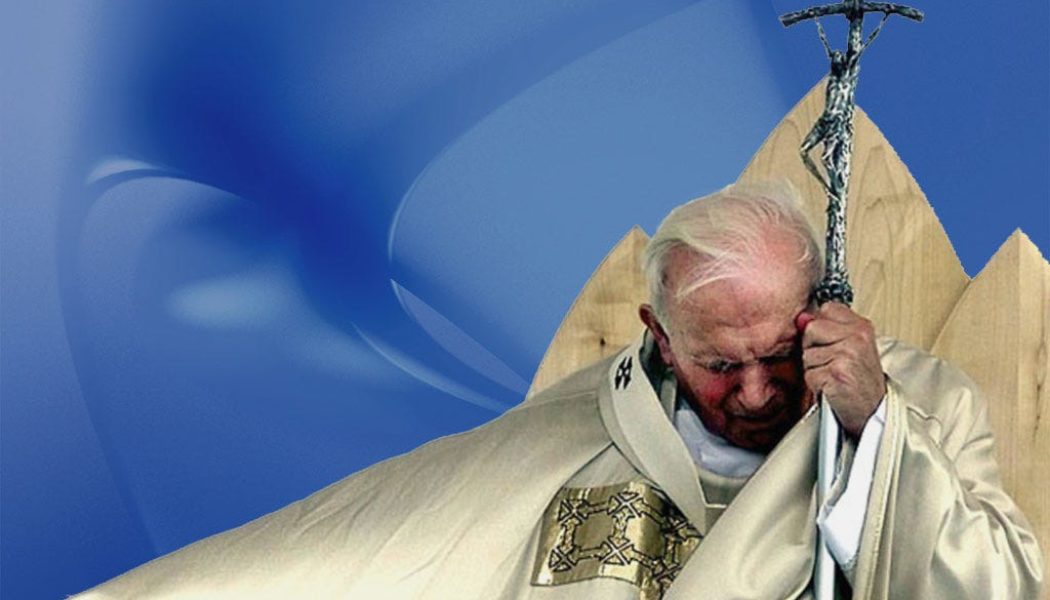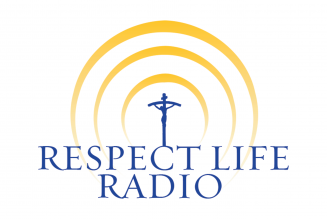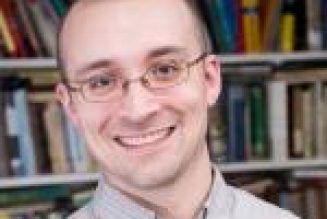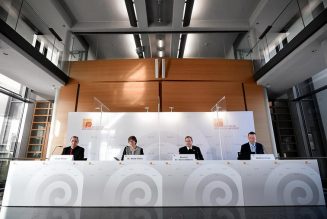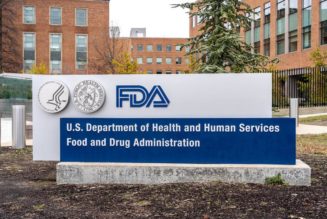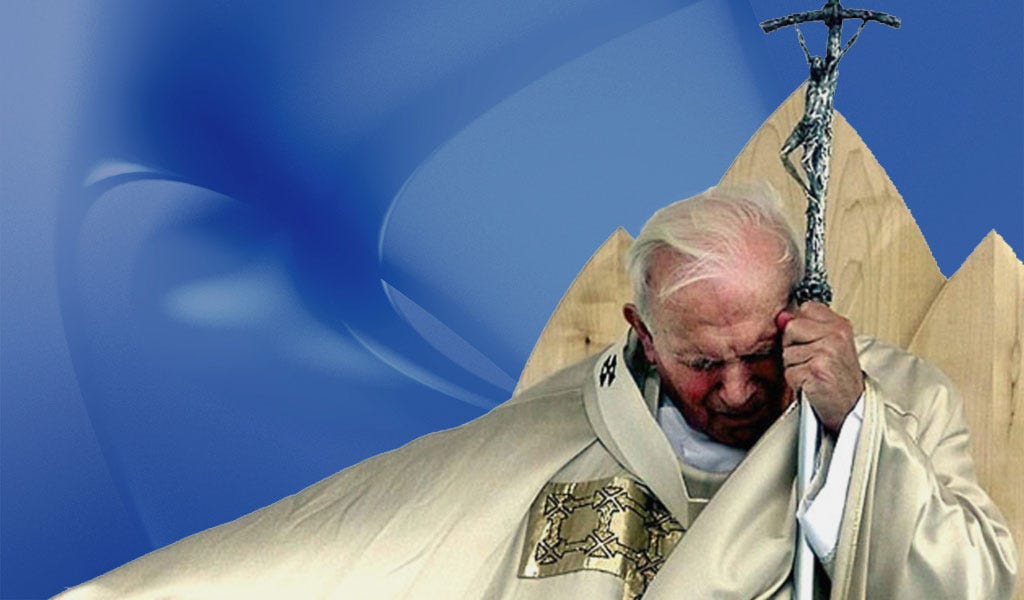
For the better part of three plus decades the Catholic Church was known in part as a faith community led by the charismatic figures of John Paul II and his deputy, Benedict XVI (Joseph Ratzinger). Their leadership was defined by many things that can be summed up as the authoritative interpreters of Vatican II, which included things like the New Evangelization, clarity in teaching, new ecclesial movements, reform of seminaries, the promulgation of the Catechism of the Catholic Church and the 1983 Code of Canon Law, forceful diplomacy that reshaped the geopolitical world, the empowerment of the laity, and so much more. George Weigel’s monumental biography of John Paul II, A Witness to Hope, is an important reminder of the expansiveness of the pontificate of John Paul II, which continued with Benedict XVI.
It is well documented, however, that a hallmark of the Francis pontificate is the neglect of John Paul II. From the relative lack of reference to John Paul’s teachings in the writings of Pope Francis, to the dismantling of the John Paul II Institute, to appointments to the College of Cardinals, dicasteries, and metropolitans, and beyond, there is plenty of evidence of our current Holy Father’s desire to go in a starkly different direction. This is not news to anyone paying attention. Although the Holy Spirit provides particular charisms for different eras, I would levy leaving John Paul II in the past as one of my sharpest criticisms of this current pontificate.
In this respect, Francis follows the earlier lead of the Catholic left, who generally disregarded John Paul II during his pontificate. The Catholic left (again, broadly speaking) ignored much of his work during those twenty-six years: from his encyclicals (notably, Veritatis Splendor), to the Catechism of the Catholic Church, to his critique of Communism and Liberation Theology, to the call for renewal in Catholic education, to his qualified support of the free market, and so much more. The Catholic left was almost embarrassed by John Paul II’s pontificate (sort of like how the Catholic right and even many of the Catholic left are embarrassed by much of Pope Francis’ pontificate).
But what has changed in recent years is a noticeable movement away from John Paul II by some on the ecclesiastical right. There is an attempt by some Catholic conservatives to redefine what it means to be a faithful Catholic. A form of pietism based on pre-Vatican II traditions is increasingly emphasized, along with a soft hostility to the legacy of John Paul II, because, in the mind of some, it gave us Pope Francis. While the more traditional devotional practices themselves are neutral, it’s troubling that the center that held under John Paul II and Benedict XVI is starting to drift.
The recent media storm around the comments from Harrison Butker was understandable and, I suppose, predictable. The surprise was the response from the live audience. Benedictine College is well-known as a place of dynamic orthodoxy. It was the first college campus to host FOCUS. It has a liberal arts program that is classical and diverse. Its vision statement quotes John Paul II’s Ex Corde Ecclesiae on Catholic education, embracing the saint’s vision for a Catholic college. There is a John Paul II student center; John Paul II fellows; and a host of John Paul II cultural indicators. In many respects Benedictine is a living example of John Paul II’s vision for the Church. And yet when Butker finished his commencement address, the crowd in attendance gave a standing ovation—even though the speech went down paths distinctly not John Paul IIish.
The address emphasized the TLM, not something John Paul II is identified with, to the diminishment of the novus ordo. It was critical of NFP, something very much a part of John Paul’s theology of the body. It broadly criticized the bishops and priests who were formed under John Paul II and are well-known to be inspired by his charism—as if errant shepherds are the rule rather than the exception. All of this, it is fair to say, runs counter to the common ecclesial culture animated by the spirit of John Paul II.
This is just one, relatively small example of the Catholic right rethinking its identity but there are other signs of movement from the Catholic right. Integralism is now a thing with some on the right; a rigorous Benedict Option wherein lay people are encouraged to flee from the world is out there (the planned Veritatis Splendor community is one extreme example); some loud voices on Catholic social media can be heard distancing themselves from John Paul II; and others are recommending the Catechism of the Council of Trent in place of the Catechism of the Catholic Church. These examples suggest the legacy of John Paul II is waning as a growing number of Catholics move on from his vision for the Church.
A closer look, however, tells a different story. While the disgruntled left will always be with us (along with their rejection of much of John Paul II’s legacy), and while there are loud voices on the right that seem to be moving further away from the canonized pontiff, the lived experience of the faith remains firmly shaped by John Paul II.
Mr. Butker’s commencement address notwithstanding, the small, Catholic colleges that surfaced in the last forty years remain firmly committed to the legacy of John Paul II. The enthusiasm expressed for Harrison Butker’s speech was likely more a general cheering for standing up to the craziness of so much that assaults the faithful on a daily basis rather than the specifics of the speech. At least, I hope it was more a rallying cry for a besieged population than an articulation of a new orientation of the Church (see Chris Stefanick’s very good video commentary).
Places like Franciscan University of Steubenville, University of Dallas, Benedictine College, Ave Maria, Thomas Aquinas College, University of Mary, The Augustine Institute, and a half a dozen more are clearly the fruit of John Paul’s vision for the Church and higher education. Their Catholic-based identities are in large part due to John Paul II, and they are the ones producing the next generation of active, faithful Catholics at scale.
The same can be said for the phenomenon of classical education at the elementary level. Take a quick look at the curriculum of these schools and it is evident that the pontificate of John Paul II, especially the Catechism of the Catholic Church, is front and center.
Of course, the Fellowship of Catholic University Students (FOCUS) is another example of John Paul II’s legacy in the United States. They evangelize on over 200 college campuses, host an annual gathering of college students that draws something close to 30,000 participants (something the Catholic left and the fringe right cannot do), and have produced countless vocations to the priesthood and religious life, not to mention the many holy marriages. There is new life, figuratively and literally, coming out of FOCUS that does not exist at practically any large Catholic university.
Seminary formation also has the distinct mark of John Paul II. Pastores Dabo Vobis, while slow and painful at times, has driven a dramatic reform of seminaries here in the United States and elsewhere. What were often hotbeds of dissent and moral confusion have become houses of faithful formation for the next generation of priests. The impact John Paul II had on seminary formation cannot be overstated. The seminaries of today look nothing like the seminaries of the 1970’s and 1980’s, thanks be to God.
Parish life is also marked by the twenty-five plus years of Pope John Paul II, with a strong assist from Pope Benedict. By and large, felt banners are out, the tabernacle has moved back to the center of the church, the Catechism of the Catholic Church is a common sight, and priests are less casual about their responsibilities. More, of course, needs to be done, but many parishes are more Christocentric in their character than a generation or two ago.
The liturgy wars still exist but there seems to be a greater appreciation for a vertically oriented novus ordo, one that includes smells and bells, silence, more reverent music, even an openness to ad orientem, which speaks to a liturgical sensibility that did not exist for much of our post-conciliar experience.
Eucharistic devotion is also in favor again thanks in part to John Paul II’s emphasis on the Real Presence. It is fair to say that the Eucharistic Revival movement led by the bishops is itself the fruit of John Paul’s own devotion to adoration and prayer before the Blessed Sacrament. Certainly, Pope Francis has encouraged this sort of devotion, but the foundation came from John Paul II.
Finally, although this does not exhaust the examples, the dominant Catholic media platforms are without a doubt the fruit of John Paul II’s ecclesiology. The barking from the left and right, while loud, is very much in the minority. Ignatius Press, EWTN, Catholic Answers, The Pillar, Catholic radio, and more are all very much in the John Paul II camp—and are the dominant voices in Catholic media. George Weigel, John Paul’s biographer, writes one of the most read weekly Catholic columns, and it is in large part because he so effectively reflects the pope’s ecclesiology. Bishop Barron’s apostolate Word on Fire, also heavily influenced by John Paul II, is a north star for many and one of the largest Catholic voices in the world.
The pope’s call to a new evangelical approach to the Church is personified in someone like Chris Stefanick, a man well-formed in the faith and zealous to talk about Jesus within the context of contemporary issues. His popularity is a testament to his talent and message but also to John Paul’s vision of the Church, which Chris is keen to emphasize.
Fran Maier’s new book, True Confessions, is a collection of conversations with the men and women who live the faith today, often heroically. There is a love for Saint John Paul II that runs throughout. His spirit shaped so much of what now defines the faithful Catholics who enter the seminary or religious life, who run Catholic apostolates, and who live quiet but heroic, Christ-centered lives at home and in the professional world.
All that being said, if our ecclesial diet is a menu of news from the Vatican or social media, it’s easy to think the Church has moved away from John Paul II. Thankfully, a look into the life of the Church tells a very different story. The Catholic Church remains deeply influenced by the historic life of the great John Paul II, even as strong forces work against his legacy. What we need now is for each of us to do our part to sustain his legacy. Are you a catechist? Teach his ecclesiology. Are you a parent? Teach your children about his life and legacy, and especially about theology of the body. Are you a priest? Preach on his vision. Of course, to do any of the above requires knowledge of John Paul II’s teachings and life, so you must first educate yourself.
Read his writings (I especially recommend Redemptor Hominis [the Redeemer of Man, and the blueprint for his pontificate], Salvifici Doloris [on the Power of Salvific Suffering], and Crossing the Threshold of Hope [an easier read]; and read about him (particularly Witness to Hope by George Weigel and Saint John Paul the Great: His Five Loves by Jason Evert [an easier read]). By immersing ourselves so, we remain connected to this great pope, who was fully animated and consumed by the life of Christ, who remains with us from now until eternity.
Jayd Henricks is the President of Catholic Laity and Clergy for Renewal. He served at the U.S. Conference of Catholic Bishops for eleven years and holds a STL in systematic theology from the Dominican House of Studies. He has written extensively on the Church in America.
